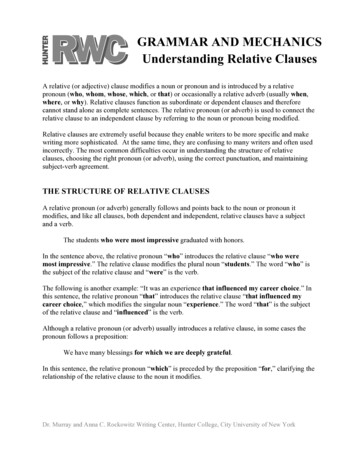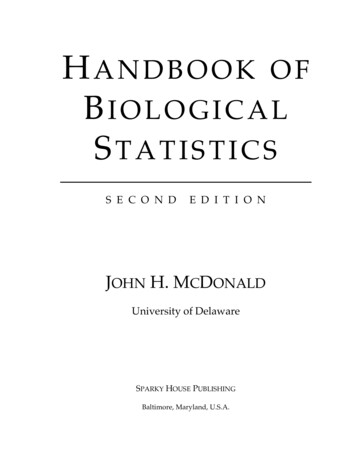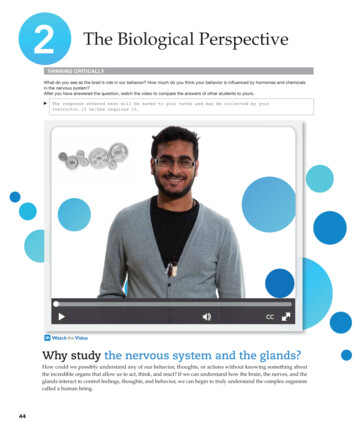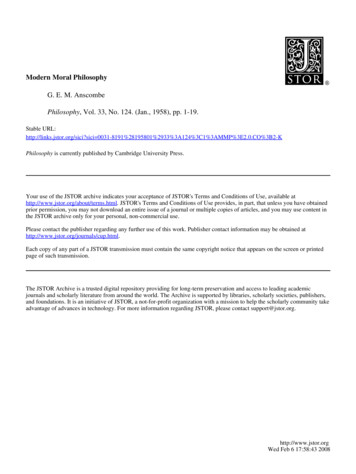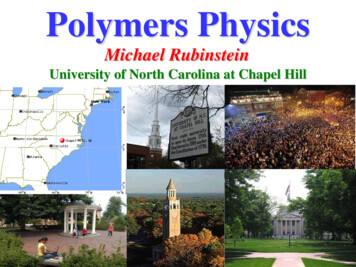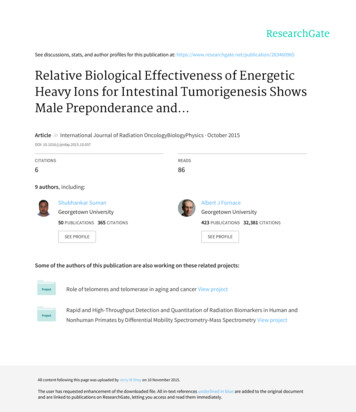
Transcription
See discussions, stats, and author profiles for this publication at: Relative Biological Effectiveness of EnergeticHeavy Ions for Intestinal Tumorigenesis ShowsMale Preponderance and.Article in International Journal of Radiation OncologyBiologyPhysics · October 2015DOI: 10.1016/j.ijrobp.2015.10.057CITATIONSREADS6869 authors, including:Shubhankar SumanAlbert J FornaceGeorgetown UniversityGeorgetown University50 PUBLICATIONS 365 CITATIONS423 PUBLICATIONS 32,381 CITATIONSSEE PROFILESEE PROFILESome of the authors of this publication are also working on these related projects:Role of telomeres and telomerase in aging and cancer View projectRapid and High-Throughput Detection and Quantitation of Radiation Biomarkers in Human andNonhuman Primates by Differential Mobility Spectrometry-Mass Spectrometry View projectAll content following this page was uploaded by Jerry W Shay on 10 November 2015.The user has requested enhancement of the downloaded file. All in-text references underlined in blue are added to the original documentand are linked to publications on ResearchGate, letting you access and read them immediately.
Accepted ManuscriptRelative biological effectiveness of energetic heavy ions for intestinal tumorigenesisshows male preponderance and radiation type and energy dependence in1638N/ APCmiceShubhankar Suman, Ph.D, Santosh Kumar, Ph.D, Bo-Hyun Moon, M.S, SteveStrawn, M.S, Hemang Thakor, M.S, Ziling Fan, M.S, Jerry W. Shay, Ph.D, Albert J.Fornace, Jr., M.D, Kamal Datta, 015.10.057Reference:ROB 23244To appear in:International Journal of Radiation Oncology Biology PhysicsReceived Date: 20 August 2015Revised Date:14 October 2015Accepted Date: 26 October 2015Please cite this article as: Suman S, Kumar S, Moon B-H, Strawn S, Thakor H, Fan Z, Shay JW,Fornace Jr. AJ, Datta K, Relative biological effectiveness of energetic heavy ions for intestinal1638N/tumorigenesis shows male preponderance and radiation type and energy dependence in APC mice, International Journal of Radiation Oncology Biology Physics (2015), doi: 10.1016/j.ijrobp.2015.10.057.This is a PDF file of an unedited manuscript that has been accepted for publication. As a service toour customers we are providing this early version of the manuscript. The manuscript will undergocopyediting, typesetting, and review of the resulting proof before it is published in its final form. Pleasenote that during the production process errors may be discovered which could affect the content, and alllegal disclaimers that apply to the journal pertain.
ACCEPTED MANUSCRIPTRelative biological effectiveness of energetic heavy ions for intestinal tumorigenesis showsmale preponderance and radiation type and energy dependence in APC1638N/ miceShubhankar Suman, Ph.D.,*, @ Santosh Kumar, Ph.D.,*, @ Bo-Hyun Moon, M.S.,* Steve Strawn,RIPTM.S.,* Hemang Thakor, M.S.,* Ziling Fan, M.S.,* Jerry W Shay, Ph.D.,# Albert J Fornace Jr.,M.D.,* Kamal Datta, M.D.*, *Department of Biochemistry and Molecular & Cellular Biology and Lombardi ComprehensiveDepartment of Cell Biology, UT Southwestern Medical Center, Dallas, TX 75390, USA.@These authors contributed equally to the work.MANU#SCCancer Center, Georgetown University, Washington, DC 20057, USA.Running title: Radiation quality and intestinal tumorKeywords: Space radiation; energetic heavy ions; colorectal cancer risk; mouse model; RBE. Corresponding author:TEDKamal Datta, M.D.,Associate Professor, Department of Biochemistry and Molecular & Cellular Biology,Georgetown University, Research Building, Room E518,EP3970 Reservoir Rd., NW, Washington, DC 20057, USA.Phone: 202-687-7956, Fax: 202-687-3140, Email: kd257@georgetown.eduACCAcknowledgementsThis study is supported by NASA Grant# NNX13AD58G and NNX09AU95G. We are thankfulto Pelagie Ake for support with the mice breeding. We are also thankful to the members of theNASA Space Radiation Laboratory especially Drs. Peter Guida and Adam Rusek at theBrookhaven National Laboratory for their support in performing this study.Conflict of Interest Notification. No actual or potential conflict of interest exists.
ACCEPTED MANUSCRIPTSummaryRadiation is a known risk factor for colorectal cancer (CRC). However, much uncertainty existsover estimates of CRC risk after energetic heavy ion radiation exposures. Relative biologicalRIPTeffectiveness (RBE) of intestinal tumor frequency for energetic 12C, 56Fe, and 28Si ions relative toγ radiation was assessed in a mouse model (APC1638N/ ) of human CRC. Research into energeticACCEPTEDMANUSCheavy ion exposure-associated risk of CRC has implications for safe space exploration.
ACCEPTED MANUSCRIPTAbstractPurpose: There are uncertainties associated with the prediction of colorectal cancer (CRC) riskfrom highly energetic heavy ion (HZE) radiation. We undertook a comprehensive assessment ofRIPTintestinal and colonic tumorigenesis induced after exposure to high linear energy transfer (highLET) HZE radiation spanning a range of dose and LET in a CRC mouse model and comparedthe results to low-LET γ radiation.SCMethods and Materials: Male and female APC1638N/ mice (n 20 mice per group) were wholebody exposed to sham-radiation, γ-rays, 12C, 28Si, or 56Fe radiation. For the 1 Gy HZE dose, weMANUused γ-ray equitoxic doses calculated using relative biological effectiveness (RBE) determinedpreviously. Mice were sacrificed 150 days after irradiation, and intestinal and colon tumorfrequency was scored.Results: The highest number of tumors was observed after 28Si followed by 56Fe and 12CTEDradiation, and tumorigenesis showed a male preponderance especially after 28Si. Analysisshowed greater tumorigenesis per unit of radiation (per cGy) at lower doses suggesting eitherradiation-induced elimination of target cells or tumorigenesis reaching a saturation point atEPhigher doses. Calculation of RBE for intestinal and colon tumorigenesis showed the highestvalue with 28Si and lower doses showed greater RBE relative to higher doses.ACCConclusions: We have demonstrated that the RBE of heavy ion radiation-induced intestinal andcolon tumorigenesis is related to ion energy, LET, and gender, and peak RBE is observed at anLET of 69 keV/µm. Our study has implications for understanding risk to astronauts undertakinglong duration space missions as well as to patients undergoing heavy ion radiotherapy.1
ACCEPTED MANUSCRIPTIntroductionIncreased risk of colorectal cancer (CRC) after exposure to low linear energy transfer (low-LET)radiation such as γ-rays has been widely reported in epidemiological as well as animal modelRIPTstudies (1-3). While on earth low-LET radiation is predominant, astronauts traveling into outerspace are exposed to high-LET energetic heavy ions (HZE) such as 12C, 56Fe and 28Si, and therisk of CRC from HZE radiation exposure remains to be established. Energetic heavy ionsSCcontribute significantly towards dose equivalent of galactic cosmic radiation (GCR), and it hasbeen predicted that during a Mars mission about 30% of the astronauts’ cell will be hit by eitherMANUthe primary or the secondary tracts of heavy ions (4-6). Considering that CRC is still a majorform of cancer in the USA and low-LET radiation is a CRC risk factor, high-LET radiationexposure could potentially pose a greater risk of developing CRC. Therefore, assessing CRCrisks associated with energetic heavy ion exposures is important for health of astronautsTEDundertaking long-duration space missions and safe exploration of outer space.Currently, we are unable to accurately predict CRC risk from exposure to HZE ions mostly dueEPto insufficient in vivo tumorigenesis data. However, with limitations in obtaining in vivo humandata on energetic heavy ions-associated CRC, there is an urgent need to accrue animal dataACCnecessary to predict CRC risk from long duration space missions. The adenomatous polyposiscoli (APC) mutant mouse models have been extensively used to study the molecularpathogenesis of CRC (12-15). It has been previously shown that exposure to 1.6 and 4 Gy of 56Fecaused higher intestinal tumorigenesis in APCMin/ relative to γ radiation (3). Increased intestinaltumorigenesis was also observed in APC1638N/ mice after 56Fe radiation (16). Considering thatspontaneous intestinal tumor frequency is markedly lower in control APC1638N/ (0 to 5 tumors)relative to APCMin/ (30 to 50 tumors) mice, radiation-induced tumorigenesis has a better signal-2
ACCEPTED MANUSCRIPTto-noise ratio in the former relative to the later mouse model (3, 16). Therefore, we utilizedAPC1638N/ to undertake a comprehensive study for a number of HZE ions (12C, 56Fe, 28Si)spanning a range of doses and LETs with the aim to determine calculated RBE values relative toRIPTγ-rays for intestinal and colonic tumorigenesis. The current study demonstrated a malepreponderance for the RBE of intestinal and colonic tumorigenesis and the RBE oftumorigenesis peaked at an LET of 69 keV/µm, which is the similar LET for the highest RBE forMANUSCsurvival reported earlier (17-22).Methods and MaterialsMice. The APC1638N/ mice on a C57BL/6J background were bred, genotyped, and maintained asdescribed previously (3, 23). Six to eight week old male and female APC1638N/ mice were used.TEDAnimal procedures were performed as per protocol approved by the Institutional Animal Careand Use Committee (IACUC) at XXXX and at XXXX and we followed the Guide for the CareEPand Use of Laboratory Animals for our studies.Irradiation. Mice, transportation, irradiation procedures, and dosimetry have been describedACCpreviously (3). Briefly, mice are shipped to XXXX and exposed to different doses of 12C (0.1.0.5, 2.0 Gy; energy: 290 MeV/n; LET: 13 keV/µm;), 56Fe (0.1, 0.5, 1.6 Gy; energy: 1000 MeV/n;LET: 148 keV/µm), and 28Si (0.1, 0.5, 1.4 Gy; energy: 300 MeV/n; LET: 69 keV/µm;) at XXXX.Mice for sham- and γ-irradiation were also shipped to XXXX and shipped back to XXXX withthe aim to expose all mice to similar transportation stressors and γ irradiation was performed onthe same day of heavy ion irradiation at XXXX using a 137Cs source. For doses below 1 Gy (0.13
ACCEPTED MANUSCRIPTand 0.5 Gy) we used γ-irradiation doses equal to those of the heavy ions. For 2 Gy γ-rays, weused equitoxic doses of 12C (2 Gy), 56Fe (1.6 Gy), and 28Si (1.4 Gy) radiation determined usingRBE factors of survival (LD50/30 studies) calculated earlier, which were 0.99, 1.25, and 1.40RIPTrespectively (21, 22).Tumor count. Mice were sacrificed using CO2 asphyxiation 150 d after radiation. The smallSCintestine and colon was surgically dissected out, cleaned, and tumors counted under a dissectionscope as previously described (3). Considering heavy ion radiation exposures are available threeMANUtimes a year for a specified time period, and logistical issues such as mice breeding andgenotyping as well as beam size (area with uniform dose), we irradiated mice in smaller groups.Subsequently, data from multiple radiation exposures were pooled for statistical significanceanalysis. Tumor frequency and RBE data from male and female mice in intestine and colon areintestine.TEDanalyzed, plotted, and presented separately. The words intestine and intestinal represent smallEPStatistical analysis and RBE calculation. Radiation-induced tumor frequency was normalizedby subtracting spontaneous tumor frequency. Normality of data distribution in each irradiatedACCgroup was tested using Shapiro-Wilk’s test (24). The p-values ( 0.05), histograms, and skewnessand kurtosis measures with standard errors revealed that the tumor data were not approximatelynormally distributed. Therefore, equality of variances were tested using a non-parametricLevene’s test (25), which reported a p-value of 0.05 showing inequality of variances in thetumor data set. Given that data showed non-normal distribution and unequal variance but wehave equal sample size (n 20 mice per study group), Welch’s one-way ANOVA with Games-4
ACCEPTED MANUSCRIPTHowell post-hoc test (26) was performed to determine significance (p 0.05 was considered assignificant) among different types of radiation-induced tumorigenesis. Statistical comparisonbetween male and female tumor frequency for a given radiation type and dose was performedRIPTusing Wilcoxon matched pairs test and p 0.05 was considered as significance. All statisticalanalysis was performed using IBM SPSS Statistics for Macintosh, Version 22.0 (IBM Corp.,Armonk, NY). Error bars represent mean standard error of mean (SEM). In each dose,SCintestinal and colonic tumor frequency scale (y-axis) is kept the same in male and female micefor comparison. For a calculated RBE of heavy ion tumorigenesis relative to γ-rays, radiation-MANUinduced tumor frequency was first normalized by subtracting spontaneous tumor frequency[(radiation tumor frequency-spontaneous tumor frequency)]. Subsequently, due to different dosesfor different radiation types at the highest doses (2 Gy and equitoxic), normalized tumorfrequency for each dose (Gy) was converted to number of tumors per cGy [(radiation tumorTEDfrequency-spontaneous tumor frequency)/radiation dose in cGy]. Calculated RBE of heavy ionradiation-induced tumorigenesis is expressed as a ratio of heavy ion and γ radiation-inducedtumor frequencies (heavy ion radiation-induced tumor frequency per cGy/γ radiation-inducedACCEPtumor frequency per cGy).ResultsIncreased frequency of intestinal tumors in APC1638N/ mice after HZE radiation. All dosesof heavy ion radiation showed increased intestinal tumorigenesis (Fig. 1, Suppl. Fig. 1, andSuppl. Table 1). In male mice, all doses of 12C, 56Fe, and 28Si showed higher intestinal tumorincidence relative to the corresponding doses of γ radiation (Fig. 1A, B, and C). Tumorigenesis5
ACCEPTED MANUSCRIPTin female mice was also significantly higher after exposure to all doses of 12C, 56Fe, and 28Siexcept after 0.1 and 0.5 Gy of 12C relative to respective γ radiation doses (Fig. 1D, E, and F).Highest intestinal tumor frequency was observed after 28Si relative to other radiation types used.relative to 12C and 56Fe radiation in males (Fig. 1B and C).RIPTAdditionally, intestinal tumorigenesis was significantly higher after 0.5 and 1.4 Gy of 28SiSCColonic tumor frequency is increased after heavy ion radiation exposures. Overall, colonictumorigenesis was also increased after exposure to three types of heavy ions (Fig. 2, Suppl. Fig.28MANU2, and Suppl. Table 2). Compared to γ radiation, tumorigenesis after all doses of 12C, 56Fe, andSi radiation was significantly higher except after 2.0 Gy 12C in male mice (Fig. 2A, B, and C).Female mice did not develop tumors after 0.1 Gy 12C radiation (Fig. 2D) and the small increasein tumorigenesis after 0.5 Gy 12C was not statistically significant (Fig. 2E). Although weTEDobserved higher colon tumorigenesis after 2.0 Gy 12C, it was not statistically significant relativeto γ radiation (Fig. 2F). In female mice, colonic tumorigenesis was significantly higher after alldoses of 56Fe and 28Si relative to the corresponding doses of γ radiation (Fig. 2D to F). ThereEPwas no statistically significant difference in tumorigenesis among comparable doses of 12C, 56Fe,and 28Si radiation except for 0.1 Gy where tumor frequency was higher after 56Fe and 28SiACCrelative to 12C. Since there was no spontaneous tumor in the colon, we calculated percent of micebearing radiation-induced colonic tumors. In male mice, 5 to 15% had colonic tumors after 0.1 to2 Gy γ radiation, 20 to 30% had tumors after 0.1 to 2 Gy 12C, 25 to 40% had tumors after 0.1 to1.6 Gy 56Fe, and 30 to 100% had tumors after 0.1 to 1.4 Gy 28Si (Fig. 2G, H, and I).6
ACCEPTED MANUSCRIPTMale mice showed higher tumorigenesis relative to female mice after 28Si irradiation. Foreach radiation dose, tumorigenesis was compared between male and female mice. Intestinaltumorigenesis was significantly higher in male relative to female mice at all doses of 28SiRIPTradiation (Fig. 3A, B, and C). However, we did not observe any significant difference inintestinal tumorigenesis between male and female mice after 12C and 56Fe radiation (Fig. 3A, B,and C). While colonic tumorigenesis was higher in male compared to female mice at all doses ofSi, we also observed higher colonic tumor frequency in male mice after 0.1 and 0.5 Gy of 12CSC28radiation (Fig. 3D, E, and F). Differences in colonic tumorigenesis in male and female miceMANUafter 56Fe and 2 Gy 12C radiation was not statistically significant (Fig. 3D, E, and F).Calculated RBE values for intestinal and colonic tumorigenesis relative to γ radiation. TheRBE for intestine and colon tumorigenesis in male and female mice after different doses of 12C,Fe, and 28Si were calculated relative to γ radiation (Suppl. Table 3). Calculated RBE forTED56intestinal tumorigenesis after 0.1 Gy 12C, 56Fe, and 28Si were 3.7, 5.6, and 8.0 in male mice and1.6, 2.7, and 3.2 in female mice respectively (Fig. 4A). For 0.5 Gy, our results showed RBE ofEP2.1, 3.0, and 5.3 in male and 1.4, 2.1, and 2.0 in female mice after 12C, 56Fe, and 28Si radiationrespectively (Fig. 4B). For 2 Gy and equitoxic doses, we calculated intestinal tumorigenesis RBEACCof 1.5, 2.3, and 4.8 in male and 1.6, 2.4, and 3.1 in female mice after 12C, 56Fe, and 28Si radiationrespectively (Fig. 4C). We calculated the RBE of colon tumorigenesis for 0.1 Gy (8, 10, and 13for 12C, 56Fe, and 28Si respectively) and 0.5 Gy (8, 10, and 14 for 12C, 56Fe, and 28Si respectively)doses in male mice (Fig 4D and E). Considering that there was no γ radiation-induced colontumor after 0.1 and 0.5 Gy doses, the RBE for these doses was not calculated in female mice. For2 Gy and equitoxic doses, the RBE for colonic tumorigenesis were 3.5, 5.6, and 9.3 for 12C, 56Fe,7
ACCEPTED MANUSCRIPTand 28Si respectively in male mice and 3.3, 5.0, and 8.1 for 12C, 56Fe, and 28Si respectively inRIPTfemale mice (Fig. 4F).DiscussionSince we do not have sufficient human data, an important approach toward space travel-SCassociated CRC risk estimation is to determine relative biological effectiveness (RBE) ofintestinal and colonic tumorigenesis in appropriate animal models for HZE radiation compared toMANUγ radiation. The RBE scaling factor from animal studies can then be used along with the lowLET human data on CRC to develop risk prediction models for HZE ions. While our previousstudies focused on 56Fe at relatively higher doses (3, 16, 23), the current study is expanded toinclude three HZE ions (12C, 28Si, and 56Fe) and three doses spanning a range of energies andrelative to γ-rays.TEDLETs to determine RBE ratio of intestinal and colonic tumor frequency in APC1638N/ miceEPStudies have shown that radiation-induced tumorigenesis is contingent upon a number of factorsincluding radiation quality and dose, and high-LET radiation has been reported to induce higherACCnumber of solid tumors relative to low-LET radiation (27-30). In this study, all three HZE ionsinduced higher intestinal and colonic tumorigenesis in mice relative to γ radiation with 28Sishowing the highest response. It is possible that differential tumorigenesis after differentirradiation results from varied physical properties such as dose distribution, and energydeposition among these radiation types leading to increased transformation due to genetic andepigenetic changes in key tumor suppressive/oncogenic pathways (31-37). However, differences8
ACCEPTED MANUSCRIPTin physical properties alone may not fully explain differential tumorigenesis observed amongthree HZE ions and it is possible that there is involvement of a component of non-targetedRIPTeffects, which could vary depending on the characteristics of the incident radiation (30, 38, 39).In both male and female mice, although tumors in excess of control mice after 0.5 and 2.0 Gydose was more than 0.1 Gy, we observed that tumorigenesis did not increase proportionatelySCrelative to radiation dose. For example, the fold increase of intestinal tumor was lower(4.25/2.8 1.5 and 9.45/2.8 3.3 fold) relative to fold increase of radiation dose from 0.1 to 0.5MANUand 2.0 Gy (0.5/0.1 5 and 2.0/0.1 20 fold) in 12C-irradiated male mice suggestingdisproportionately lower increase at higher doses. Indeed, tumor incidence per unit of 12Cradiation (cGy) showed greater increase after the lower doses compared to the higher doses(2.8/10 0.28 tumors per cGy after 0.1 Gy and 4.25/50 0.08 after 0.5 Gy compared toTED9.45/200 0.05 per cGy after 2 Gy). These results could be interpreted to suggest that saturationeffects is at play which could be due to futile multiple hits of the same cell as well as due toEPdemise of potential tumorigenic cells after high dose exposures (40, 41).Age-adjusted CRC incidence, grade, and mortality is higher for men relative to women and isACCattributed to sex-specific differential exposure to environmental risk factors andendogenous/exogenous protective factors such as estrogen (41-46). Importantly, epidemiologicaldata from the atom bomb survivor Life Span Study (LSS) cohort (47) as well as fromoccupational radiation exposure cohort (48) demonstrated that excess relative risk for CRC ishigher in men compared to women and thus male preponderance is also maintained in radiationexposure associated CRC. Our earlier study in APC1638N/ mice, which was a life span study,9
ACCEPTED MANUSCRIPTshowed higher intestinal tumorigenesis in male relative to female mice specifically after a highdose of γ radiation (49). In the current study, although we observed increasing trend oftumorigenesis in male mice after γ radiation, it was not statistically significant. This could be dueRIPTto the lower doses as well as due to the ‘time-dependent’ design (50) of this study, which had afixed ending time point at 150 d post-exposure. Conversely, frequency of tumorigenesis wassignificantly higher in male relative to female mice after 28Si and to some extent after 12CSCradiation. Notably, tumorigenesis was not statistically significant between male and female miceMANUexposed to 56Fe and is consistent with our previous results (16).Analysis of RBE values support the notion that particle energy, LET, and RBE are interlinked.When we compared 28Si with 56Fe, we observed higher RBE for 28Si than 56Fe at all doses andcould be due to differences in LET (53, 54). Additionally, comparing results in femaleTEDAPC1638N/ and APCMin/ (3) from our current and previous studies respectively after 2 Gy γ-raysand equitoxic 1.6 Gy 56Fe, showed that the calculated RBEs of intestinal tumorigenesis weresimilar (2.42 in APC1638N/ and 2.80 in APCMin/ ) suggesting consistency of results across twoEPmodels. Our study showing differential RBE after 12C and 28Si at similar energies can be partlyexplained since LET is linked to the Z-values of the particles and two particles at similarACCenergies have differing LET and thus RBEs (20). In contrast, 28Si with a lower Z-value comparedto 56Fe showed higher RBE and may be due to differences in energy, and hence LET and isconsistent with earlier reports (55). Evidence in the literature suggests that RBE shows anupsurge up to an LET of 100 keV/µm and above this the RBE declines (54, 55), which has beenattributed to beam and particle characteristics described earlier (40). The RBE of heavy ions isrelated to the LET, Z-value, and importantly to their energy deposition pattern. Overall, our data10
ACCEPTED MANUSCRIPTshowed that lower radiation doses have greater RBE relative to higher doses for intestinal andcolonic tumorigenesis and is similar to the reports on heavy ion radiation-induced hepatocellularcarcinoma development (30). Developing risk estimates for CRC following energetic heavy ionRIPTis a priority for future space missions and therefore, it is essential that we determinegastrointestinal tissue specific biological effects for heavy ions using surrogate endpointsrelevant to known human disease processes. Also, our relative comparison of tumorigenesisSCbetween γ-rays and heavy ion radiation could be further utilized to model in-depth RBE values atmuch lower doses for extended and mixed heavy ion radiation filed exposures expected duringMANUspace missions. Finally, our in vivo tumorigenesis data and RBE in a mouse model of humanCRC is an important step towards developing heavy ion exposure-associated CRC risk predictionmodels as well as preventive strategies for human.TEDReferences1. Preston DL, Shimizu Y, Pierce DA et al. Studies of mortality of atomic bomb survivors.Report 13: solid cancer and noncancer disease mortality: 1950-1997. 2003. Radiat ResEP2012;178:AV146-AV172.2. Henderson TO, Oeffinger KC, Whitton J et al. Secondary gastrointestinal cancer in childhoodACCcancer survivors: a cohort study. Ann Intern Med 2012;156:757-66, W.3.XXXX.4. Curtis SB, Letaw JR. Galactic cosmic rays and cell-hit frequencies outside the magnetosphere.Adv Space Res 1989;9:293-298.5. Setlow RB. The hazards of space travel. EMBO Rep 2003;4:1013-1016.11
ACCEPTED MANUSCRIPT6. Hayatsu K, Hareyama M, Kobayashi S et al. HZE Particle and Neutron Dosages from CosmicRays on the Lunar Surface. J Phys Soc Jpn 2009;78:149-152.7. Ohno T. Particle radiotherapy with carbon ion beams. EPMA J 2013;4:9.RIPT8. Okada T, Kamada T, Tsuji H et al. Carbon ion radiotherapy: clinical experiences at NationalInstitute of Radiological Science (NIRS). J Radiat Res 2010;51:355-364.9. Schulz-Ertner D, Jakel O, Schlegel W. Radiation therapy with charged particles. Semin RadiatSCOncol 2006;16:249-259.Clin Oncol 2012;42:670-685.MANU10. Tsujii H, Kamada T. A review of update clinical results of carbon ion radiotherapy. Jpn J11. Imaoka T, Nishimura M, Kakinuma S et al. High relative biologic effectiveness of carbon ionradiation on induction of rat mammary carcinoma and its lack of H-ras and Tp53 mutations. Int JRadiat Oncol Biol Phys 2007;69:194-203.TED12. Fodde R, Edelmann W, Yang K et al. A targeted chain-termination mutation in the mouseApc gene results in multiple intestinal tumors. Proc Natl Acad Sci U S A 1994;91:8969-8973.13. XXXX.2001;7:369-373.EP14. Fodde R, Smits R. Disease model: familial adenomatous polyposis. Trends Mol MedACC15. Rosenberg DW, Giardina C, Tanaka T. Mouse models for the study of colon carcinogenesis.Carcinogenesis 2009;30:183-196.16. XXXX.17. Alpen EL, Powers-Risius P, McDonald M. Survival of intestinal crypt cells after exposure tohigh Z, high-energy charged particles. Radiat Res 1980;83:677-687.12
ACCEPTED MANUSCRIPT18. Aoki M, Furusawa Y, Yamada T. LET dependency of heavy-ion induced apoptosis in V79cells. J Radiat Res (Tokyo) 2000;41:163-175.19. Lett JT. Damage to cellular DNA from particulate radiations, the efficacy of its processingchromatin breaks. Radiat Environ Biophys 1992;31:257-277.RIPTand the radiosensitivity of mammalian cells. Emphasis on DNA double strand breaks and20. Rodriguez A, Alpen EL, Powers-Risius P. The RBE-LET relationship for rodent intestinalSCcrypt cell survival, testes weight loss, and multicellular spheroid cell survival after heavy-ion21. XXXX.22. XXXX.23. XXXX.MANUirradiation. Radiat Res 1992;132:184-192.24. Shapiro SS, Wilk MB. An Analysis of Variance Test for Normality (Complete Samples).TEDBiometrika 1965;52:591-611.25. Nordstokke DW, Zumbo BD. A new nonparametric Levene test for equal variances.Psicologica 2010;31:401-430.EP26. McDonald JH. Handbook of Biological Statistics. 2014145-156.27. Alpen EL, Powers-Risius P, Curtis SB et al. Tumorigenic potential of high-Z, high-LETACCcharged-particle radiations. Radiat Res 1993;136:382-391.28. Ullrich RL, Jernigan MC, Cosgrove GE et al. The influence of dose and dose rate on theincidence of neoplastic disease in RFM mice after neutron irradiation. Radiat Res 1976;68:115131.13
ACCEPTED MANUSCRIPT29. Weil MM, Bedford JS, Bielefeldt-Ohmann H et al. Incidence of acute myeloid leukemia andhepatocellular carcinoma in mice irradiated with 1 GeV/nucleon (56)Fe ions. Radiat Res2009;172:213-219.RIPT30. Weil MM, Ray FA, Genik PC et al. Effects of 28Si ions, 56Fe ions, and protons on theinduction of murine acute myeloid leukemia and hepatocellular carcinoma. PLoS One2014;9:e104819.SC31. Kronenberg A. Mutation induction in human lymphoid cells by energetic heavy ions. AdvSpace Res 1994;14:339-346.MANU32. Kronenberg A. Radiation-induced genomic instability. Int J Radiat Biol 1994;66:603-609.33. Kronenberg A, Gauny S, Criddle K et al. Heavy ion mutagenesis: linear energy transfereffects and genetic linkage. Radiat Environ Biophys 1995;34:73-78.34. Ding LH, Shingyoji M, Chen F et al. Gene expression changes in normal human skinTEDfibroblasts induced by HZE-particle radiation. Radiat Res 2005;164:523-526.35. Ding LH, Shingyoji M, Chen F et al. Gene expression profiles of normal human fibroblastsafter exposure to ionizing radiation: a comparative study of low and high doses. Radiat ResEP2005;164:17-26.36. Templin T, Amundson SA, Brenner DJ et al. Whole mouse blood microRNA as biomarkersACCfor exposure to gamma-rays and (56)Fe ion. Int J Radiat Biol 2011;87:653-662.37. Asaithamby A, Uematsu N, Chatterjee A et al. Repair of HZE-particle-induced DNA doublestrand breaks in normal human fibroblasts. Radiat Res 2008;169:437-446.38. Buonanno M, de Toledo SM, Pain D et al. Long-term consequences of radiation-inducedbystander effects depend on radiation quality and dose and correlate with oxidative stress. RadiatRes 2011;175:405-415.14
ACCEPTED MANUSCRIPT39. Morgan WF. Is there a common mechanism underlying genomic instability, bystander effectsand other nontargeted effects of exposure to ionizing radiation? Oncogene 2003;22:7094-7099.40. Alpen EL, Powers-Risius P, Curtis SB et al. Fluence-based relative biological effectivenessRIPTfor charged particle carcinogenesis in mouse Harderian gland. Adv Space Res 1994;14:573-581.41. Koo JH, Leong RW. Sex differences in epidemiological, clinical and patholo
This study is supported by NASA Grant# NNX13AD58G and NNX09AU95G. We are thankful to Pelagie Ake for support with the mice breeding. We are also thankful to the members of the NASA Space Radiation Laboratory especially Drs. Peter Guida and Adam Rusek at the Brookhaven National Laboratory for their support in performing this study.
